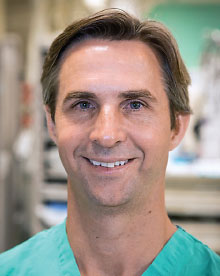High-Dose Buprenorphine in the ED Effective for OUD
Abstract
Patients with opioid use disorder who come to the emergency department often do not want to wait several days for buprenorphine to provide relief from their cravings. Doses higher than the standard induction of 8 mg to 12 mg may offer them a safe option.
Offering buprenorphine to patients who come to the emergency department (ED) with opioid use disorder (OUD) is more common than it was several years ago, but the existing treatment guidelines by the Department of Health and Human Services were developed for treatment in office-based practices, not the ED. The guidelines limit the maximum sublingual dose during the first 24 hours of treatment to 8 to 12 mg, which means it may take two to three days to achieve therapeutic levels of the medication. Yet many people with OUD who come to the ED are in crisis and need treatment that works faster than that.

Higher doses of buprenorphine should be considered only in patients who are generally healthy aside from their OUD. —Andrew A. Herring, M.D.
“They are looking for an effect that they can feel quickly and are not necessarily going to trust a lengthy process whereby the benefits of the medication are felt days later,” said Andrew A. Herring, M.D., an attending emergency physician and the associate director of research at Highland Hospital-Alameda Health System in Oakland, Calif. He is an assistant clinical professor at the University of California, San Francisco. “There is a very high risk that these patients will return to using opioids immediately after leaving the emergency department, so you want to achieve a blockade dose as quickly as possible to prevent overdose.”
Herring, the medical director of the hospital’s substance use disorder treatment program, is the lead author of a study in JAMA Network Open that suggests that using higher doses of buprenorphine—doses greater than 12 mg—during induction is safe and well-tolerated in patients with OUD.
“When we looked at the evidence, there was no clear reason for the guidelines to require three days to achieve a therapeutic dose,” Herring told Psychiatric News, adding that although the guidelines recommend lower doses, using higher doses is not unheard of, especially for patients whose OUD is severe.
Herring and his colleagues reviewed the records of 391 patients with OUD who were treated with buprenorphine at Highland Hospital in 2018. Some of the patients had multiple visits to the ED, bringing the total number of cases in the study to 579. Higher doses of buprenorphine were given to patients in 63.2% of cases overall and doses of 28 mg or more were given in 23.8% of cases overall.
When the researchers reviewed the vital signs recorded in the patients’ records, they found no significant association between buprenorphine dose and blood pressure, respiratory rate, heart rate, and oxygen saturation. Overall, there were five cases of precipitated withdrawal—intense withdrawal symptoms brought on by the medication—but four of them occurred in patients who received a dose of 8 mg.
Herring said that while a higher dose of buprenorphine can be effective and well tolerated, it’s not for everyone who comes to the ED with OUD. For example, patients with congestive heart failure would not be good candidates for a higher dose because of buprenorphine’s potential sedating and respiratory effects.
“[G]ood clinicians using sound judgment should feel like they can use higher doses in people who are generally healthy [aside from their OUD],” he explained.
Patients with greater opioid dependence and tolerance are more likely to derive a benefit from a higher dose, Herring said. To determine which patients might be good candidates for a higher dose, he suggests simply asking them how often they use opioids and how much they take.
“People are usually quite credible historians regarding their own use,” he said.
Herring added that higher doses of buprenorphine may be particularly useful for patients at safety-net hospitals, those that offer health care regardless of a patient’s insurance status or ability to pay. Highland is one such hospital, and 22.5% of the patients in the study were homeless.
“These patients exist in a world of very pressing survival needs because of their socioeconomic status and other social determinants of care,” Herring said. “Recognize that after discharge, many patients face a system that is fundamentally fragmented, and they experience it as hostile and discriminatory.”
Herring explained that because using a higher dose extends buprenorphine’s duration of action, it buys both the patient and health professionals several days to arrange for follow-up and continued treatment.
“There’s a real role for this in making both patient and [health professional] more comfortable with discharging the patient,” he said. “We can tell them, ‘We know you have a lot going on, but at least right now you are safe.’ ”
This study was supported in part by grant funding through the National Institute on Drug Abuse. ■
High-Dose Buprenorphine Induction in the Emergency Department for Treatment of Opioid Use Disorder” is posted here.



